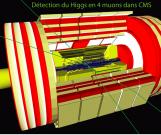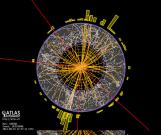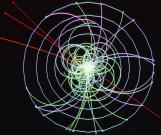How much do you know about the Higgs boson?
Higgs boson, the missing piece in the Standard Model of Particle Physics

October 29, 2012 by admin
On July 4th of this year, physicists working on the LHC experiments CMS and ATLAS at CERN announced the observation of a new particle whose properties need still to be determined in order to be fully identify with the Higgs boson, the missing piece in the Standard Model of Particle Physics. The behavior of this new particle so far has been "consistent with" a Higgs boson.
The Standard model of particle Physics has succesfully explained the elementary particles and their forces for more than forty years of experimental probes. However, without the existence of a Higgs boson, the Standard model of particle physics is unable to explain how some of its particles get their masses. In the sixties, several theoretical particle physicists demanded the existence of a new particle, the Higgs boson, which couples to particles and the particles acquire masses via this mechanism.
In the standard model, at high temperatures, above the electroweak symmetry breaking scale, the electroweak symmetry is unbroken and above this scale all the particles are massless. Below this scale, the symmetry is spontaneously broken and the W and Z bosons acquire masses. Leptons and quaks can also acquire masses via their couplings with the Higgs field. The Higgs mechanism can be regarded as the superconductivity of the vacuum.
What is a Higgs field and what is the higgs boson?
The Higgs field is like a giant vat of molasses distributed in the universe. Particles stick to it, and this Higgs field makes the particles heavier. The Higgs particle is the carrier of the Higgs field, as, for instance, the photon, which is the carrier of the electromagnetic field.
How long scientists have been looking for the Higgs boson?
For more than twenty years, starting at the LEP experiment at CERN (Switzerland), and after in Tevatron (US) and now in the LHC experiment at CERN.
How do physicists create a Higgs boson?
Aarticle accelerator like the LHC can recreate the consitions of the very early universe particles colliding at very high energies may produce other particles like the Higgs boson, although only one collision per trillion will originate a Higgs particle.
How do physicists know when they have found a Higgs boson?
The Higgs boson, like other heavy particles, decays into lighter particles. This process can follow a certain number of paths, which depend on the mass and the nature of the particles. Physicists study the decay paths they observe after a particle collision to the decay paths that different theoretical models predict, and then determine the nature of the particle that decays and also its mass, adding the energies of the lighter particles produced in the decay.
-
Why is it called the Higgs particle?
Peter Higgs wrote two papers on the existence of such a particle, becoming the first to mention explicitly that the t...





